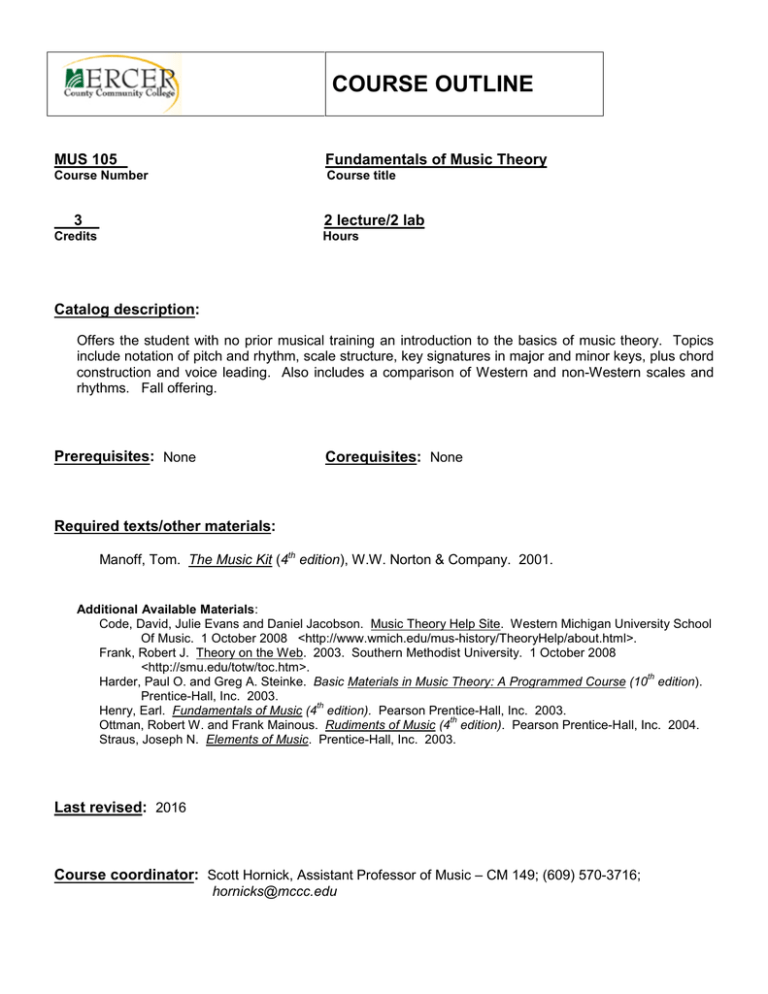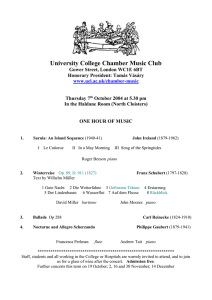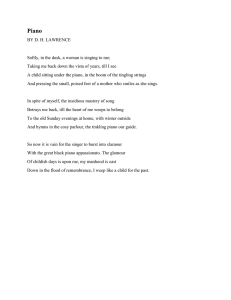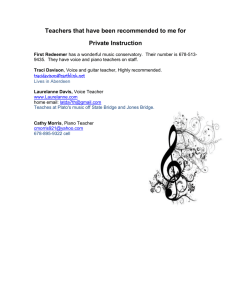
COURSE OUTLINE
MUS 105
Fundamentals of Music Theory
Course Number
Course title
3
2 lecture/2 lab
Credits
Hours
Catalog description:
Offers the student with no prior musical training an introduction to the basics of music theory. Topics
include notation of pitch and rhythm, scale structure, key signatures in major and minor keys, plus chord
construction and voice leading. Also includes a comparison of Western and non-Western scales and
rhythms. Fall offering.
Prerequisites: None
Corequisites: None
Required texts/other materials:
Manoff, Tom. The Music Kit (4th edition), W.W. Norton & Company. 2001.
Additional Available Materials:
Code, David, Julie Evans and Daniel Jacobson. Music Theory Help Site. Western Michigan University School
Of Music. 1 October 2008 <http://www.wmich.edu/mus-history/TheoryHelp/about.html>.
Frank, Robert J. Theory on the Web. 2003. Southern Methodist University. 1 October 2008
<http://smu.edu/totw/toc.htm>.
th
Harder, Paul O. and Greg A. Steinke. Basic Materials in Music Theory: A Programmed Course (10 edition).
Prentice-Hall, Inc. 2003.
th
Henry, Earl. Fundamentals of Music (4 edition). Pearson Prentice-Hall, Inc. 2003.
th
Ottman, Robert W. and Frank Mainous. Rudiments of Music (4 edition). Pearson Prentice-Hall, Inc. 2004.
Straus, Joseph N. Elements of Music. Prentice-Hall, Inc. 2003.
Last revised: 2016
Course coordinator: Scott Hornick, Assistant Professor of Music – CM 149; (609) 570-3716;
hornicks@mccc.edu
Page 2 of 13
Course Goals:
The student will be able to:
1. Demonstrate proficiency in the proper notation of music on treble and bass clefs on the levels of both
pitch and rhythm. (MCCC Core Skills A and B)
2. Internalize the layout and structure of the piano keyboard, using it as a cognitive template for the
measurement of pitch relationships, intervallic distance, and the proper construction of scalar and chordal
configurations. (MCCC Core Skills B)
3. Comprehend and demonstrate a working command of the structural rudiments of tonal music including
pitch, intervals, scales, and chords. (MCCC Core Skills B and D)
4. Understand the formal principles that govern the interplay of the structural elements of music in the
creation of cohesive musical statements and ideas. (MCCC Core Skills B and D)
5. Understand music as a mode of thought whose elements of expression find coherence through both
syntactic and mathematical forms of organization. (MCCC Core Skills B, D and F)
MCCC Core Skills
Goal A. Written and Oral Communication in English. Students will communicate effectively in speech and writing, and demonstrate
proficiency in reading.
Goal B. Critical Thinking and Problem-solving. Students will use critical thinking and problem solving skills in analyzing information.
Goal D. Information Literacy. Students will recognize when information is needed and have the knowledge and skills to locate,
evaluate, and effectively use information for college level work.
Goal F. Collaboration and Cooperation. Students will develop the interpersonal skills required for effective performance in group
situations.
Academic Integrity Policy
As stated in the student handbook, “A student will be guilty of violating academic integrity if he/she
(a) knowingly represents the work of others as his/her own, (b) uses or obtains unauthorized
assistance in the execution of academic work, or (c) gives fraudulent assistance to another
student.” Students should read the Academic Integrity policy in the MCCC Rights and
Responsibilities Handbook.
Academic Dishonesty will result in failure of this course.
Page 3 of 13
Units of Study and Learning Objectives
UNIT I: The Concept of Notation and Pitch
The student will be able to:
1. Understand and articulate the concept of pitch as a discrete tone of specific
vibrational frequency that serves as the basic structural unit of melody.
2. Comprehend and explain how tones of different pitch are organized incrementally
from “low to high,” resulting in the phenomenon of acoustic space.
3. Know the seven letter names (A through G) used to designate pitches and
understand that these seven letters are employed as a repeating series to
identify the 90 or so pitches that exist in the audible spectrum.
4. Understand the concept and the phenomenon of the octave and explain its
structural significance.
5. Execute the proper notation of pitch by placing the appropriate symbols (notes)
onto a system of five lines and four spaces (staff) using both the treble and bass
clefs.
6. Correctly identify at sight the letter name of any pitch from its symbolic
representation in the form of a note.
UNIT II: The Piano Keyboard; Whole Steps and Half Steps
The student will be able to:
1. Understand and explain the patterned configuration of keys on the piano
keyboard.
2. Demonstrate a working knowledge of the correspondence between a notated
pitch and its location of the piano keyboard.
3. Correctly notate a pitch on staff paper based on its location on the piano
keyboard.
4. Comprehend and explain the half steps as the smallest structurally significant
increment of pitch change in Western tonal music. (CG3; CSGA)
5. Cite the distance of the half as being represented by the span of two adjacent
keys on the piano keyboard. (CG’s 2 and 3)
6. Expand the modifying symbols of sharp, flat, and natural (#,β,ν) and correctly
employ these symbols to indicate directional half step inflections to notes of
specific letter names. E.g.: F
F#, B
B β, C#
Cν
(CG’s 1 and 3;
Gen. Ed. Goal 2; CSGB)
7. Understand that the whole step constitutes the next most important increment of
pitch change in tonal music and comprises the distance of two half steps. (CG3)
Page 4 of 13
8. Notate on staff paper any two pitches separated by a whole step, using the
necessary accidentals (#,β,ν). (CG’s 1 and 3; Gen. Ed. G2; CSGB)
9. Locate the position of any notated whole step on the piano keyboard.
(CG’s 1, 2 and
3)
10. Explain and demonstrate a working knowledge of the concept of enharmonic
equivalence, especially as it applies to the identification of black keys on the
#
β
#
β
piano. E.g.: G = A , C = D , etc. (CG’s 1,2, and 3; Gen. Ed. 2; CSG’s A and B)
11. Notate the chromatic scale, ascending and descending, throughout the range of
four octaves and know each note’s location on the piano keyboard. (CG’s 1, 2 and 3)
UNIT III: Rhythmic Notation I
The student will be able to:
1. Understand that the written musical line consists of a series of notated pitches,
each of which bears a specific durational value that is indicated in the notation.
(CG’s 1 and 3; Gen. Ed. G2; CSGB)
2. Comprehend and explain that the rhythmic aspect of notation conveys the
duration of a pitch as measured against an underlying, evenly recurring pulse or
beat. (CG’s 1 and 3; Gen. Ed. G2; CSGB)
3. Understand rhythmic symbols as representations of specific composites or
subdivisions of beats, each bearing an exact fractional value relative to the unit of
pulse. (CG’s 1 and 3; Gen. Ed. G2; CSGB)
4. Correctly identify, notate, and execute the rhythmic values of whole note, half
(CG’s 1 and 3; Gen. Ed. G2;
note, quarter note, and eighth note (ω, η , θ , ε) .
CSGB)
5. Understand, explain, and execute time signatures that employ the quarter note
as the unit of pulse.
(CG’s 1 and 3; Gen. Ed. G2; CSGB)
E.g.:
4
4
3
4
2
4
6
4
UNIT IV: The Major Scale
The student will be able to:
1. Understand the concept of scale as a logically and incrementally ordered series
of pitches that forms the basis of melodic construction. (CG’s 3 and 4; Gen. Ed. G2)
2. Memorize and articulate the whole step-half step pattern that constitutes the
major scale. (CG’s 3 and 4; Gen. Ed. G2; CSGB)
3. Spell, notate, and play at the piano, the scale of C major and employ it as a
template for the construction of other major scales. (CG’s 2, 3 and 4; Gen. Ed. G2; CSGB)
Page 5 of 13
4. Spell and notate the major scale on each of fifteen starting notes, correctly using
the appropriate accidentals (#, β) necessary to preserve the whole step-half step
template in each transposition. (CG’s 1, 3 and 4; Gen. Ed. G2; CSGB)
5. Memorize and construct the key signature for each of the fifteen major keys,
using the appropriate configuration of accidentals. (CG’s 1, 3, and 4)
6. Memorize the circle of 5ths and understand its significance as an organizing
principle in tonal music. (CG’s 3, 4 and 5)
7. Transpose simple diatonic melodies notated in a given key up or down to a
specified different key, using the appropriate accidentals needed to preserve the
intervallic profile of the original melody. (CG’s 1, 3, 4 and 5; Gen. Ed. G2; CSGB)
UNIT V: Rhythmic Notation II
The student will be able to:
1. Execute the notation of more minute and complex subdivisions of the beat, such
as sixteenth notes (
,
) and dotted notes (
). (CG’s 1,
,
3 and 4; Gen. Ed. G2; CSGB)
2. Execute and notate rhythmic figures in time signatures employing note values
other than the quarter note as the basic unit of pulse.
E.g.:
(CG’s 1, 3 and 4; Gen. Ed. G2; CSGB)
2
4
3
6
2
2
8
8
UNIT VI: Intervals
The student will be able to:
1. Understand and explain the term “interval” as the distance between any two
pitches measured in terms of the composite of half steps that separate them.
(CG’s 3, 4 and 5; Gen. Ed. G2)
2. Identify the broad-based categories of interval (2nd, 3rd, 4th, 5th, 6th, 7th, octave) as
measured by the number of scale steps separating any two pitches. (CG’s 3, 4 and
5; Gen. Ed. G2)
3. Apply the modifying terms of major, minor, augmented, diminished, and perfect
to achieve a more finely calibrated distinction within each of the broad-based
numerical interval categories (major 3rd vs. minor 3rd, perfect 5th vs. diminished 5th
or augmented 5th, etc.). (CG’s 3, 4 and 5; Gen. Ed. G2; CSGB)
4. Precisely identify the interval between two pitches in terms of both its numerical
β
th
β
value and the appropriate modifier. E.g.: G to E = minor 6 ; D to C =
th
diminished 7
(CG’s 3 and 4; Gen. Ed. G2; CSGB)
5. Understand, explain, and apply the concept of interval inversion.
Ed. G2; CSGA)
(CG’s 3 and 4; Gen.
Page 6 of 13
6. Notate on staff paper and locate on the piano keyboard any intervallic dyad
throughout the range of four octaves. (CG’s 1,2,3 and 4)
7. Transpose and correctly notate any intervallic dyad up or down a specified
β
intervallic distance, maintaining the integrity of the original interval. E.g.: G to B
th
β
up a perfect 4 = C to E
(CG’s 1, 3, 4 and 5; Gen. Ed. G2; CSGB)
8. Understand and explain the structural significance of intervals and the role they
play in the proper construction of scales, chords, and melodies.
(CG’s 3, 4 and 5;
CSGA)
UNIT VII: The Minor Scales
The student will be able to:
1. Memorize and articulate the whole step-half step pattern that constitutes the
minor scale in each of its three forms---natural, harmonic, and melodic. (CG’s 3
and 4; Gen. Ed. G2)
2. Understand and explain that the three distinct forms of the minor scale are the
result of half step modifications of scale degrees 6 and 7. (CG’s 3 and 4; Gen. Ed. G2,
CSGA)
3. Cite and identify the melodic conditions under which each, or both, scale degree
modifications occur. (CG’s 1, 3 and 4; Gen. Ed. G2; CSG’s A and B)
4. Spell and notate the minor scale in each of its three forms at each of the fifteen
levels of transposition, using the appropriate accidentals. (CG’s 1, 2, 3 and 4; Gen. Ed.
G2; CSGB)
5. Memorize and construct the key signature for each of the fifteen minor keys.
(CG’s 1, 3 and 4)
6. Understand and explain the concept of relative minor, noting that each minor
scale is related to a parent scale and is governed by the same key signature.
(CG’s 1, 3, 4 and 5)
7. Know and demonstrate the precise intervallic distance between the tonic of any
major key and the tonic of its relative minor. (CG’s 1, 3 and 4; Gen. Ed. G2; CSGB)
8. Cite from memory the relative minor of all fifteen major keys.
(CG 1 and 3)
9. Execute at the piano keyboard the three forms of the minor scale in a variety of
keys. (CG’s 2, 3 and 4)
UNIT VIII: Triads and the Concept of Harmony
The student will be able to:
Page 7 of 13
1. Understand and explain the structure of the triad as a specific intervallic
configuration of three pitches that serves as the basic structural unit of harmony.
(CG’s 3, 4 and 5; Gen. Ed. G2; CSGA)
2.
Identify and define the four classes of triad (major, minor, augmented, and
diminished), citing the specific intervallic structure of each. (CG’s 3, 4 and 5; Gen. Ed.
G2; CSGA)
3. Spell, notate, and name any triad in each of its four forms from any given root
note. (CG’s 1, 3 and 4; Gen. Ed. G2; CSG’s A and B)
4. Construct and play at the piano keyboard any triad proceeding from its name: Dβ
#
major, F minor, C diminished, etc. (CG’s 1, 2, 3, and 4; Gen. Ed. G2; CSGB)
5. Proceed from a given notated triad and apply the necessary structural
modifications to transform it into its other three forms, both on staff paper and at
the piano keyboard. (CG’s 1, 2, 3, 4 and 5; Gen. Ed. G2; CSGB)
6. Identify by name any triad as notated in either normal form or spread position, as
well as in each of its two inverted forms. (CG’s 1, 3, 4 and 5; Gen. Ed. G2; CSGB)
UNIT IX: The Tonal System and the Functional Hierarchy of Triads within a Key
The student will be able to:
1. Understand and explain the concept of tonality or key as the functional
interaction of melody and harmony. (CG’s 3, 4 and 5; CSGA)
2. Understand and demonstrate the derivation of triads from a parent major scale.
(CG’s 3, 4 and 5; Gen. Ed. G2; CSG’s A and B)
3.
Ascribe a Roman numeral designation to each of seven triads derived from the
major scale corresponding to the scale degree from which each is derived and
reflecting the quality (major, minor, diminished) of each triad through the use of
upper and lower case numerals (I, ii, iii, IV, V, vi, viio).
(CG’s 1, 3, 4 and 5; Gen. Ed.
G2; CSGB)
4. Understand the relative functional strength of each triad and explain the role that
each plays in establishing the primacy of the tonic (I). (CG’s 3, 4 and 5)
5. Apply objectives 2, 3, 4 in the context of minor keys noting the additional triads
engendered by the chromatic alterations of scale degrees 6 and 7. (CG’s 3, 4 and 5;
Gen. Ed. G2; CSG’s A and B)
6. Perform a harmonic analysis on a passage of music using the Roman numeral
designations. (CG’s 1, 3, 4 and 5; Gen. Ed. G2; CSGB)
7. Ascertain the key implied by a fragmentary chord progression that employs only
two or three triads. (CG’s 1, 3, 4 and 5; CSGB)
8. Play at the piano, short progressions of triads in a variety of major and minor
keys. (CG’s 2, 3 and 4)
Page 8 of 13
Evaluation of Student Learning
Each student’s attainment of both course level objectives and unit level learning outcomes
will be assessed using the following means of evaluation.
Evaluation Tools
%
of
Grade
Completion of and performance on weekly reading and written homework
assignments
Periodic quizzes (six to eight) designed to assess the student’s level of
mastery of concepts and procedures studied in class
A comprehensive and inclusive final examination
30%
Attendance and participation in class discussion
15%
MUS105 Topical Outline
30%
25%
Page 9 of 13
WEEK 1
Pitch Notation— Treble and bass clef’s, pitch names, and their locations
on the staves.
WEEK 2
The Piano Keyboard— Layout of the keyboard, location of pitches,
notation of sharps and flats, identification of the black keys, enharmonic
equivalents.
WEEK 3
Rhythmic Notation— Quarter notes and eighth notes, proper notation
and execution, quarter rests, meter and time signatures.
WEEK 4
Whole Steps and Half Steps— On the staff and on the keyboard,
accidentals (naturals, double sharp and double flat).
WEEK 5
a. Rhythm Continued— Review of the eighth notes and quarter notes;
the eighth rest.
b. The Major Scale-- Structure, placement of half steps and whole
steps, notation in various keys using accidentals; whole notes, half notes,
anacrusis.
WEEK 6
The Major Scale cont.— Scale degrees, key signatures, circle of fifths,
accidentals, transposition; sixteenth notes, dotted notes and ties.
WEEK 7
The Major Scale cont.— Review of key signatures, circle of fifths,
accidentals, transposition of melodies.
At this point student must have circle of fifths memorized, and be conversant with all major
keys through five sharps and five flats, and be able to play these scales at the piano.
WEEK 8
Intervals— Counting staff steps, half steps, interval inversion, quality of
intervals; ties and dotted notes continued.
WEEK 9
Intervals cont.— Natural intervals, adding accidentals, consonance and
dissonance; counting and executing sixteenth notes.
WEEK 10
Minor Scales— The natural minor scale, concept of relative minor,
parallel minor, key signatures; sixteenth notes continued.
WEEK 11
Minor Scales cont.— The harmonic and melodic forms of the minor
scale; compound meters.
WEEK 12
Triads— Major and minor triads in their inversions; compound meters
continued.
WEEK 13
Triads cont.— Inversions, diminished and augmented triads; triplets.
Page 10 of 13
WEEK 14
The Harmonic System— Chords within a key, triads identified by Roman
numeral in major and minor keys, harmonic analysis.
WEEK 15
The Harmonic System cont.— Chords in minor keys, including the
dominant triad and leading tone triad; review for final.
WEEK 16
In-Class Final Evaluation— Written portion will include notation of major
and minor scales and key signatures, construction and identification of
major, minor, and diminished triads, and numerical identification of triads
in a variety of major keys.
Keyboard portion will include the playing of selected major scales as well
as minor scales in their harmonic and melodic forms, construction and
identification of triad types. It will also include the playing of triads in
scalar sequence through several major keys and the performance of
selected melodies from Scorereader that will demonstrate proficiency in
executing a variety of rhythmic figures.
MUS105 Assignment Schedule
Page 11 of 13
(some exercises will be completed in class)
W EEK 1
W EEK 2
Class 1
Workbook: Chapter 1, ex. 1-11
Class 2
Workbook: Chapter 1, ex. 12-18
Class 1
Workbook: Chapter 2, ex. 1-6 and review exercises
from Chapter 1
Workbook: Chapter 2, ex. 7-8
Piano: Play from Workbook and Chapter 1, ex. 18
Class 2
W EEK 3
W EEK 4
W EEK 5
Class 1
Rhythm Reader: Chapter 1, ex. 1-9
Workbook: Review exercises from Chapter 2
Class 2
Rhythm Reader: Chapter 2, ex. 1-10
(Ex. 9 to be practiced at the piano- You will be
quizzed!)
Scorebook: p. 121 #46 and p 122 #48 -- copy out
and name each note. (Do not include lyrics.)
Class 1
Workbook: Chapter 3, ex. 1-9
Class 2
Workbook: Chapter 3, ex. 10-15 and handout
(converting whole steps to half steps and vice
versa)
Piano: Scorebook, p. 107 #3, p. 108 #5
Class 1
Rhythm Reader: Chapter 3, ex. 1-8
(Ex. 8 at piano - You will be quizzed!)
Scorebook: p. 126 no. 55 - copy out and bracket
and identify all whole steps and half steps.
Workbook: Chapter 4, ex. 1-5 (hand in ex. 1 using
sharps and flats).
And review exercises from Chapter 3.
Class 2
W EEK 6
Class 1
Workbook: Chapter 4, ex. 6 (hand in written-out
transposed versions of each melody) and review
exercises from Chapter 4.
Page 12 of 13
Rhythm Reader: Chapter 4, ex. 1-8 (ex. 1 & 5 at
piano)
Piano: G major and F major scales.
W EEK 7
Class 2
Workbook: Chapter 5, ex. 4 & 5
Rhythm Reader: Chapter 4, ex. 9 at piano
Piano: Review G major and F major scales.
Class 1
Workbook: Chapter 5, ex. 6, 7, and 9a (hand in 9a
on separate manuscript paper).
Rhythm Reader: Chapter 5, ex. 4, 6 & 7 (ex. 7 at
piano)
Piano: D major and Bβ major scales.
Workbook: Chapter 5, ex. 9b, c & d (on separate
manuscript paper to be handed in).
Rhythm Reader: Review Chapter 5, ex. 7 at piano.
Piano: Review scales C, G, F, D, and Bβ major.
Class 2
W EEK 8
Class 1
Workbook: Chapter 5, ex. 11 and Review
exercises
Rhythm Reader: Chapter 6, ex. 1, 2 & 3 (ex. 2
at piano)
Class 2
MID-TERM EXAM
Rhythm Reader: Chapter 6, ex. 4, 5, 6, and 7
(ex. 7 at piano)
W EEK 9
W EEK 10
Class 1
Workbook: Chapter 4, ex. 8-11 and review
exercises 5 & 6
Rhythm Reader: Chapter 6, ex. 7 & 8
Class 2
Workbook: Chapter 6, ex. 1-4
Rhythm Reader: Chapter 6, ex. 11 at piano
Piano: A and Eβ major scales
Class 1
Workbook: Chapter 6, ex. 5-8
Rhythm Reader: Chapter 7, ex. 3 & 4
Piano: Continue A and Eβ major scales.
Class 2
Workbook: Chapter 6 ex. 9-13
Rhythm Reader: Chapter 7, ex. 5-7 (ex. 6 at
piano)
Page 13 of 13
W EEK 11
W EEK 12
W EEK 13
W EEK 14
W EEK 15
Class 1
Workbook: Chapter 6, ex. 14 & 15 and review
exercises.
Rhythm Reader: Chapter 7, ex. 8, 9, & 11 (ex.
11 at piano)
Class 2
Workbook: Chapter 7, ex. 1-5
Rhythm Reader: Chapter 7 (review ex. 11 at
piano)
Class 1
Workbook: Chapter 7, ex. 9-11
Rhythm Reader: Chapter 8, ex. 1-4
Class 2
Workbook: Chapter 7, ex 12
Rhythm Reader: Review exercises
Class 1
Workbook: Chapter 8, ex. 1-4
Rhythm Reader: Chapter 8, ex. 10 at piano
Class 2
Workbook: Chapter 8, ex. 5-8
Rhythm Reader: Chapter 8, ex. 10 at piano
Class 1
Workbook: Chapter 8, ex. 9 & 10
Rhythm Reader: Review exercises in Chapter 9,
ex. 1-5
Class 2
Workbook: Chapter 9, ex. 7 and handout
Rhythm Reader: Chapter 9, ex. 10 at piano
Class 1
Workbook: Complete Chapter 9
Rhythm Reader: Chapter 9, ex. 10
Class 2
REVIEW FOR FINAL EXAM



